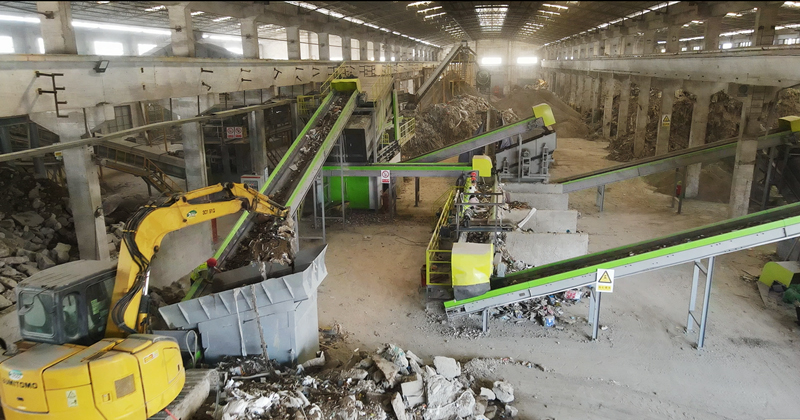 Time:2025-01-02
Time:2025-01-02
 Source:青绿环境
Source:青绿环境
Construction waste sorting equipment is a mechanized system specifically designed for handling discarded building materials. Through technologies such as vibration screening, magnetic separation, and air separation, it efficiently separates different materials such as concrete blocks, metals, and plastics, achieving resource recycling and reuse, and promoting the development of green building circular economy.

I. Needs Analysis
1. Processing Capacity
- Estimated Processing Volume: Assess the required processing capacity based on the daily or peak production of construction waste. For example, plan to process 500 tons of construction waste per day.
- Equipment Capacity: Select equipment that can handle the estimated processing volume to avoid processing bottlenecks due to insufficient capacity.
2. Types of Waste
- Main Component Analysis: Construction waste typically includes concrete blocks, bricks and tiles, metals, wood, plastics, etc. Identifying the main components helps in choosing the appropriate sorting technology.
- Impurity Proportion: Understand the proportion of impurities in the waste, such as soil and dust, to select equipment with effective pre-treatment functions.
3. Budget Constraints
- Capital Investment: Clarify the budget range available for purchasing equipment, including initial investment and subsequent maintenance costs.
- Cost-Effectiveness Consideration: Choose the equipment with the best performance and most suitable for needs within the budget.
II. Equipment Comparison
1. Vibrating Screen
- Advantages: Simple structure, easy maintenance, suitable for preliminary classification and impurity removal.
- Disadvantages: Poor classification effect on irregularly shaped materials, which may affect subsequent sorting accuracy.
2. Magnetic Separator
- Advantages: Efficiently recovers metal components, reducing resource waste.
- Disadvantages: Only applicable to magnetic metals, ineffective for non-magnetic substances.
3. Air Separator
- Advantages: Suitable for separating lightweight materials such as plastics and paper, environmentally friendly and low energy consumption.
- Disadvantages: Heavily affected by weather, not suitable for outdoor or windy environments.
4. Optical Sorter
- Advantages: Distinguishes objects of different colors or materials through image recognition technology, high precision, and strong customization.
- Disadvantages: Relatively high cost, suitable for fine sorting needs.
III. Performance Evaluation
1. Sorting Efficiency
- Processing Speed: The amount of waste processed per unit of time, directly affecting overall processing capacity.
- Accuracy: The proportion of correctly sorted waste, related to the recycling rate of resources and the difficulty of subsequent processing.
2. Energy Consumption
- Power Consumption: The electricity or other energy consumption required for equipment operation.
- Energy-Saving and Environmentally Friendly Design: Prioritize equipment with low energy consumption and environmentally friendly design.
3. Maintenance Costs
- Frequency of Wearing Parts Replacement: Understand the consumable parts of the equipment and their replacement cycles and costs.
- Maintenance Requirements: Consider the difficulty and cost of equipment maintenance and care.
IV. Manufacturer Selection
1. Reputation and Word of Mouth
- Brand Recognition: Choose well-known brands, which are usually more reliable.
- User Reviews: Refer to the usage experiences and evaluations of other users.
2. After-Sales Service
- Warranty Policy: Understand the manufacturer's warranty period and scope.
- Technical Support: Ensure the manufacturer provides timely and effective technical support and services.
V. Summary and Suggestions
1. Clarify Needs: Before choosing sorting equipment, clarify specific needs, including processing volume, types of waste, budget, etc.
2. Comprehensive Evaluation: Compare the advantages and disadvantages of different types of sorting equipment and consider them comprehensively according to needs.
3. Focus on Performance: In addition to price factors, pay more attention to equipment performance evaluation, including sorting efficiency, energy consumption, and maintenance costs.
4. Choose Reliable Manufacturers: Prioritize manufacturers with good reputation and complete after-sales service to ensure the long-term stable operation of the equipment.
5. Pay Attention to Technological Innovation: With the development of technology, new sorting technologies and equipment are emerging. Paying attention to and understanding these new technologies helps make wiser choices.













 Prev
Prev











